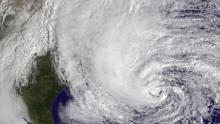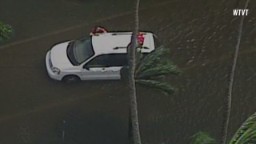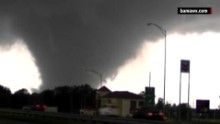begin quote from:
Dangerous heat dome forming
High temperatures, 'corn sweat' form dangerous heat dome over U.S.
Story highlights
- Some of the hottest temperatures of the summer are expected this week
- Heat kills more people in the United States than all other natural disasters combined
(CNN)The
dog days of summer are hitting hard this year, and forecasters warn
that some of the hottest temperatures of the season may sear a large
portion of the United States this week.
Very
high humidity is expected to accompany the heat, especially in the
Midwest, and that moisture -- combined with the high temperatures --
will create what's known as a "heat dome" over most of the country. Only
the Northwest will be spared.
Those
conditions could be deadly. Forecasters say the heat index, which
measures what the temperature really feels like when you add in the
humidity -- the summer equivalent of the winter wind chill -- will
likely reach the dangerous category, increasing the risks of heat
exhaustion, heat stroke, and death.
Cities
such as Des Moines, Kansas City, St. Louis, Minneapolis, Oklahoma City
and Chicago are expected to see temperatures nearing or exceeding 100
degrees -- and when humidity is added in, the heat index may rise to a
dangerous 120 degrees.
Heat is one
of the deadliest weather events, killing hundreds of people every year.
Extreme heat results in even more heat-related illnesses.
When
extreme heat is combined with elevated humidity, it can be
exceptionally dangerous. High humidity slows evaporation -- or sweating
-- which is the body's cooling mechanism. If the body can't properly
cool down, heat exhaustion is likely within as little as an hour.
Because men sweat more than women, men are more susceptible to heat
illness because they become dehydrated more quickly.
Chicago heat wave
In
1995, Chicago experienced its worst heat wave ever recorded. During a
5-day period in mid-July, at least 465 people died from the heat and
hundreds more suffered from heat-related illnesses.
The
temperature reached 106 degrees at Midway Airport on the first day of
the heat wave, and remained at or above 100 degrees for seven hours.
The
high humidity levels made this heat wave particularly severe. Dew
points were in the upper 70s to 80 degrees, making the temperature feel
like 125. On top of the heat, the lake breeze that usually rolls off of
Lake Michigan was absent. Air conditioners ran almost non-stop, causing a
2-day power outage and leaving 49,000 households miserable and in the
dark. Chicago was described as a city "roasting under a wool blanket".
Many people who died lived in
brick buildings, which trapped the heat inside. Some people feared
opening their windows because of Chicago's high crime rate. Refrigerated
trucks had to be brought in to help overwhelmed morgues. Roads buckled
and drawbridges had to be hosed down to close properly.
During
that same year, more than 1,000 people died from the heat across the
United States, making it the deadliest year for heat fatalities in more
than 30 years. Chicago's heat wave was responsible for nearly half of
those deaths.
Corn sweat could be to blame
When
you think of areas with high heat and humidity, you may think of Miami,
New Orleans or Houston, not Chicago. But the Windy City and other
Midwest cities such as St. Louis, Kansas City and Minneapolis can get
very humid, especially during a summer heat wave.
One
of your favorite veggies could be partly to blame. Densely planted corn
fields in the Midwest have been known to boost dew points -- an
indicator that meteorologists use to measure the amount of moisture in
the atmosphere -- to levels that are usually only found in the tropics.
The corn crops pull moisture from the soil and some of that moisture
escapes into the atmosphere, literally forming a very high "pool" of
moisture. This can unfold on a grand scale in the Midwest, known as the
nation's corn belt, leading to very high heat index values and misery
for millions of people.
Urban heat island
Half
of the world's population lives in an urban heat island, a term that
might conjure up images of a tropical paradise complete with palm trees
and tiki bars. But it's quite the opposite: Urban heat islands are
metropolitan areas that swelter due to a more dense infrastructure and
more paved roads, both of which absorb more heat. These factors,
combined with pollution from human activities, result in an urban heat
island.
These areas can run 5
degrees warmer during the day and as high as 20 degrees warmer at night.
Some communities have started trying to reduce the urban heat island
effect by planting more vegetation in urban areas, using cooler pavement
material and installing roofs that reflect more sunlight than they
absorb. By the year 2030, the number of people living in an urban heat
island could increase by 70%.
When nighttime brings no relief
It
seems counterintuitive, but the temperatures overnight may actually be
just as dangerous, or even more dangerous than when temperatures are
highest during the day. Studies show that when temperatures don't cool
off at night, and especially when they remain above 80 degrees, your
body, which should be in recovery mode, can't recover. The results of
not being able to fully cool down can be deadly.
Another
surprising fact is that most heat-related deaths don't occur in the
hottest weather zones. People in those regions are more equipped to deal
with the heat, with better infrastructure, building materials, and
access to air conditioning.
Beating the heat
Join the conversation
See the latest news and share your comments with CNN Weather on Facebook and Twitter.
- Drink plenty of water. Avoid drinks with alcohol or caffeine, which will only dehydrate you faster.
- Eat light meals. Avoid heavy meals that are high in protein, which cause the body to work harder to digest. Eat more carbohydrates so your body doesn't have to use as much energy to digest.
- Wear light-colored clothing, which will reflect sunlight instead of absorbing it. It could keep your body temperature down several degrees.
- Studies show the best clothes to wear while exercising are none at all! This is because air needs to flow over your skin in order for sweat to cool you off -- as much of it as possible. But if that's not an option, loose-fitting clothing is your next best bet.
- Find an air conditioned place to get out of the heat. In temperatures above 80 degrees, fans won't do you any good -- the


























No comments:
Post a Comment